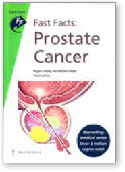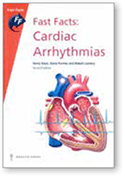Fast facts: Prostate Cancer
By Roger Kirby and Manish Patel
 In the book’s introduction, the authors state ‘we summarize our current knowledge of the most common cancer in men’. They do a very good job. This is an excellent update covering all the clinical aspects of prostate cancer management in 2014.
In the book’s introduction, the authors state ‘we summarize our current knowledge of the most common cancer in men’. They do a very good job. This is an excellent update covering all the clinical aspects of prostate cancer management in 2014.
There is a chapter about testing for prostate cancer, a summary of the available evidence from the major trials and a discussion about the debate for and against testing.
The authors give a helpful explanation of treatments available at different stages of the disease, including the pros and cons of treatment options for localised prostate cancer, prostate-specific antigen recurrence after primary treatment (advanced prostate cancer) and metastatic disease. Surgery, radiotherapy, active surveillance, androgen deprivation therapy, chemotherapy, abiraterone and newer agents (eg. radium 223, immunotherapy and enzalutamide), hopefully available to Australian patients in the near future, are all discussed, as well as less conventional options that patients might ask about. There is a chapter on survivorship issues and treatment complications.
The book is well laid out and has clear tables and diagrams to help the reader quickly access summaries of the text. Key references are listed at the end of each chapter and there is a handy colour-coded chapter index printed on the back cover to help the reader quickly find required information.
On the resources page, apart from the Prostate Cancer Foundation of Australia, there are no other Australia specific resources listed. However, there are numerous websites listed for international prostate cancer information sites.
This book can help the reader makes sense of prostate cancer testing and management and help guide the reader when counselling and managing these patients and their families.
I highly recommend this book for any general practitioner, health professional or student involved in men’s health and seeing men with prostate cancer. It is excellent.
Dr Jane Crowe
Fast facts: Cardiac Arrhythmias, 2nd edn.
Gerry Kaye, Steve Furniss, Robert Lemery
 Cardiac arrhythmias can be a complex topic. Many a frontline clinician has poor knowledge and competence in managing patients presenting with cardiac arrhythmias. Any practical assistance for clinician education in this area is always most welcome. Fast facts: Cardiac Arrhythmias is a useful book that addresses this issue in a clear, concise and comprehensive manner. The authors are eminent clinicians in the field of cardiac electrophysiology and pacing. They have done a commendable job in explaining the important points about arrhythmias in the clinical setting.
Cardiac arrhythmias can be a complex topic. Many a frontline clinician has poor knowledge and competence in managing patients presenting with cardiac arrhythmias. Any practical assistance for clinician education in this area is always most welcome. Fast facts: Cardiac Arrhythmias is a useful book that addresses this issue in a clear, concise and comprehensive manner. The authors are eminent clinicians in the field of cardiac electrophysiology and pacing. They have done a commendable job in explaining the important points about arrhythmias in the clinical setting.
The first chapter is a timely refresher of the basic anatomy and physiology of the cardiac conduction system. It lays the foundation for the next chapter, which deals with the classification and mechanismis of arrhythmias. The third chapter reviews in detail the presenting symptoms of cardiac rhythm disorders. It provides useful instructions for history taking so that even the subtlest evidence could be probed to avoid missing the possible diagnosis. The next chapter provides a detailed overview of the investigations that would be useful in various contexts. Sometimes clinicians are faced with a dilemma of how best to investigate latent arrhythmias as the different investigational modalities provide different levels of yield in those back in stable sinus rhythm. The authors of this book effectively simplify the process of deciding the most appropriate and useful investigations on the basis of the clinical findings.
The next chapter provides a broad overview of the fundamental principles for management various cardiac arrhythmias. This complex topic is presented in a simple and straightforward way that even the non-electrophysiologist can understand The authors present well-organised pathways that simplify the therapeutic decision-making process
The various types of supraventricular tachycardias (SVT), including investigation and management of SVTs, are outlined. The authors offer useful warnings on common mistakes that the unwary clinician might make when treating arrhythmias.
The section on atrial fibrillation is very comprehensive and up-to-date. Ventricular tachycardia (VT) is another area that is challenging even for seasoned clinicians. The book explains the different types of VT and gives practical information on aetiology to management of these malignant and often life-threatening pathologies.
The book ends with an overview of the bradyarrhythmias and conduction defects, followed by a discussion on pacemakers and implantable devices. This section too provides very valuable information for the clinician who manage these patients.
Cardiovascular diagnostics and therapeutics is likely to evolve but I am sure this book will remain relevant and current for a considerable time yet. Tables summarising the main points of each chapter help with revision of key elements.
This is a great book that provides practical information a busy clinician needs to understand and manage patients presenting to with heart rhythm disorders. It serves the purpose of a practical handbook on arrhythmia management.
Rohan Jayasinghe